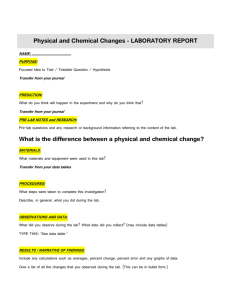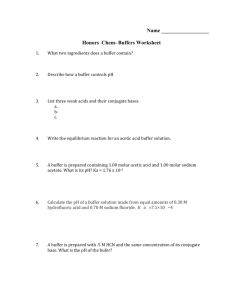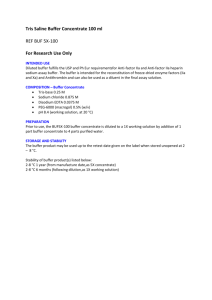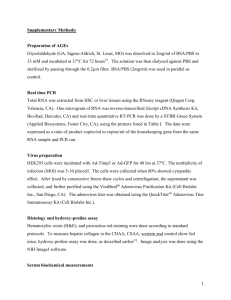tubes assays
advertisement
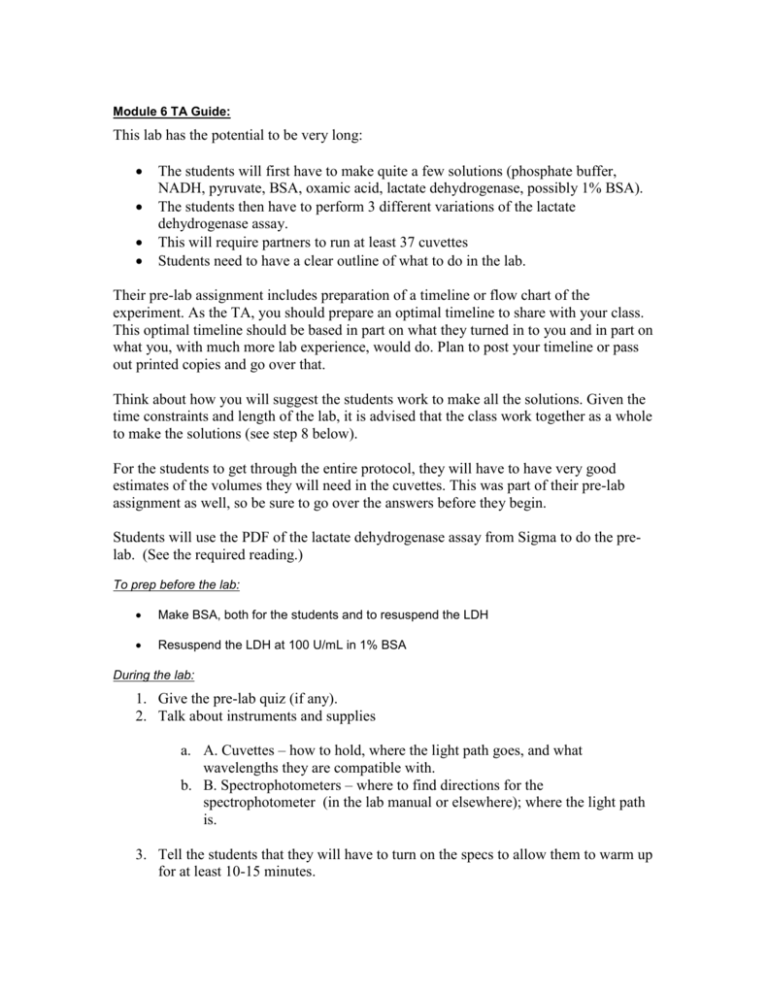
Module 6 TA Guide: This lab has the potential to be very long: The students will first have to make quite a few solutions (phosphate buffer, NADH, pyruvate, BSA, oxamic acid, lactate dehydrogenase, possibly 1% BSA). The students then have to perform 3 different variations of the lactate dehydrogenase assay. This will require partners to run at least 37 cuvettes Students need to have a clear outline of what to do in the lab. Their pre-lab assignment includes preparation of a timeline or flow chart of the experiment. As the TA, you should prepare an optimal timeline to share with your class. This optimal timeline should be based in part on what they turned in to you and in part on what you, with much more lab experience, would do. Plan to post your timeline or pass out printed copies and go over that. Think about how you will suggest the students work to make all the solutions. Given the time constraints and length of the lab, it is advised that the class work together as a whole to make the solutions (see step 8 below). For the students to get through the entire protocol, they will have to have very good estimates of the volumes they will need in the cuvettes. This was part of their pre-lab assignment as well, so be sure to go over the answers before they begin. Students will use the PDF of the lactate dehydrogenase assay from Sigma to do the prelab. (See the required reading.) To prep before the lab: Make BSA, both for the students and to resuspend the LDH Resuspend the LDH at 100 U/mL in 1% BSA During the lab: 1. Give the pre-lab quiz (if any). 2. Talk about instruments and supplies a. A. Cuvettes – how to hold, where the light path goes, and what wavelengths they are compatible with. b. B. Spectrophotometers – where to find directions for the spectrophotometer (in the lab manual or elsewhere); where the light path is. 3. Tell the students that they will have to turn on the specs to allow them to warm up for at least 10-15 minutes. 4. Go over the pre-lab assignment and make sure they are on track. Pay close attention to their volumes so that they aren't wasting too many materials. If you prepare a handout for them outlining how they should have made the calculations it might facilitate the discussion. 5. This lab requires students to prepare a lot of solutions. It is up to each TA how to handle this. If students want to work together to make and share some solutions across lab pairs, that is fine and might be good for efficiency. However everyone should have done the calculations and have them in their lab notebooks. 6. The importance of having freshly made solutions should be emphasized. 7. They should have estimated how much of each solution they will need per pair in the pre-lab assignment. Each lab pair will be using approximately: a. 1 mL LDH (at most) (at 0.6U/mL) (This can be provided to them at 100 U/mL in 1% BSA). Students need to dilute 100U/mL stock to 0.6 U/mL (the upper end of the concentration range given in the Sigma assay). For example, take 6 L stock to 994 L of 1% BSA. Make sure they know to use BSA! Each student pair should have their own enzyme stock to keep on ice at their station. b. 1 mL NADH @ 11 mM in cold dH2O (Sigma N8129 or equivalent) c. 2 mL pyruvate @ 20 mM in cold dH2O (Sigma P2256 or equivalent)) d. 1 mL 1% BSA (w/v) (Sigma A4503 or equivalent) e. ~33 mL phosphate buffer @100 mM, pH 7.0 (Sigma P5379) f. 1 mL of oxamic acid @ 60 mM in phosphate buffer (Sigma O3750) Check in their pre-labs that they didn’t estimate too much. If their values are higher than the above mentioned values, then they estimated too much, since those numbers are already an overestimation just in case they spill something or need to redo an assay. 8. If you choose to have groups work together to make solutions, talk about the solution calculations. Delegate one solution to each group if you choose (There are 5 solutions; if there are more than 5 groups, have 2 work on the phosphate buffer or let a group prepare the 1% BSA. One group should make a diluted LDH stock for each set of partners.). These are the approximate volumes needed for a lab of 12-14 students: a. NADH – make 10 mL for the class (78 mg/10 mL dH2O) (MAKE SURE THEY KNOW THE SCALE WILL READ AS 0.078 g) (MW 709.4) b. Pyruvate – make 20 mL for the class (44 mg/20 mL dH2O) (MW 110.04) c. BSA – This should already be made for the class, since the LDH was dissolved in BSA (1 g/100 mL dH2O) d. Oxamic acid – make 10 mL for the class (53 mg/10 mL PHOSPHATE BUFFER); make sure they make this in the correct buffer (MW 89.05) e. Potassium phosphate buffer, made as directed in the Sigma assay; make ~400 mL. (MW 136.09) Therefore 5.44 g/400 mL for 100 mM. pH with KOH. f. LDH - each student group should have their own to keep on ice at their station. They need to dilute 100U/mL to 0.6 U/mL. (Take 6 L to 994 L of 1% BSA.) Make sure they know to use BSA!! 9. Talk about the 3 parts of the experiment and what will differ in the 3 parts. Be sure to remind them to do all assays in duplicate. It is to the TAs discretion how much of this is provided and how much the students are expected to answer on their own. Part I. Experimental determination of optimal LDH concentration: A. Make a blank. This can be used throughout the lab to blank. Ask them WHY DO WE USE dH2O? (It compensates for the NADH, which is made in dH2O.) B. Vary the amount of LDH. Use 1% BSA to compensate for difference in the LDH because the LDH is made in 1% BSA. Make a cocktail (each volume x 13 = enough for 12 cuvettes and “error”). Point out that cuvette one is a negative control (containing no enzyme) and will be used to subtract the background rate. The other 5 cuvettes have varying concentrations of LDH (from .0022 U/mL to 0.011 U/mL). Part II:VMAX and KM determination: C. Vary the amount of substrate (pyruvate). This will depend on the optimal enzyme concentration they select in part I. Let’s assume they go with 7.4 L of enzyme. Again, there are only 3 things in the cocktail but this time one is the 1% BSA (to keep it the same as Part I) and pyruvate is not in the cocktail. For this part, the want the amount of substrate to be less than in Part I, because in Part I it was saturating. To get kinetics, we need values below saturating. I chose to start at 1/10 in the example and work up. This is up to them, as long as they stay below what was done in Part I (<37 L). I chose to do 0.1, 0.2, 0.4 and 0.7x the original pyruvate concentration. They still add enzyme LAST. Part III: Inhibition of Lactate Dehydrogenase Activity D. Add oxamic acid inhibitor. The table will be identical to above but with less buffer and 75 L of oxamic acid (since oxamic acid is in phosphate buffer, we compensate for the oxamic acid by decreasing the amount of buffer).This is assuming they make the oxamic acid at 60 mM. They still add enzyme LAST. Answers to Pre-lab assignment: For this pre-lab assignment, there aren't really "right" or "wrong" answers for grading. There are "more" right answers but what we want is for them to be thinking about how they will approach the experiment and to catch them early if they aren't thinking about it properly. The pre-lab should catch if they: plan to make 10x too much solution (or much too little) plan to only do each cuvette one time (we want duplicates) have put no time into reading the required materials (they won't be able to decide what buffer to prepare). 1. Timeline or flow chart – this will be different for all but something along these lines: 1. Make solutions 2. Turn on spec 3. Set up first set of cuvettes 4. Make cocktail for part I 5. Run part I assays in duplicate 6. Graph data from part I 7. Choose optimal concentration 8. Set up cuvettes for part II 9. Make cocktail for part II 10. Run assays for part II 11. Set up cuvettes for part III 12. Make cocktail for part III 13. Run assays for part III 2. Estimate volumes (see #7 above): ~1 mL LDH or less at 0.6 U/mL ~1 mL NADH ~2 mL pyruvate ~35 mL phosphate buffer ~2 mL 1% BSA (to dilute LDH and for assays) 3. Potassium phosphate buffer pH 7.0 (per Sigma assay). Make as described in assay or some way that makes sense. 4. Oxamic acid - need 5.3 mg/1 mL of phosphate buffer for a 60 mM solution. 5. How many cuvettes? ~37 (12 x 3 + 1 for blank, unless they make a specific blank for each part, then 12 x 3 + 3 for blanks.) 3 conical tubes to make cocktails. Conical tubes to make solutions in. Eppendorf tubes to dilute LDH in.


